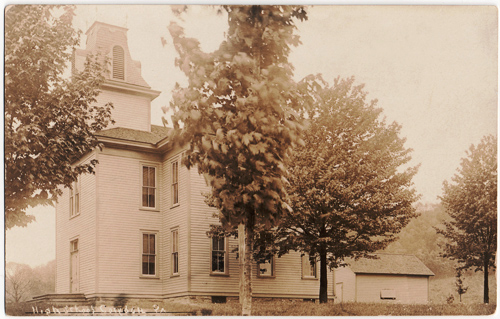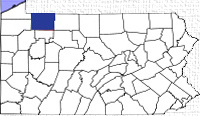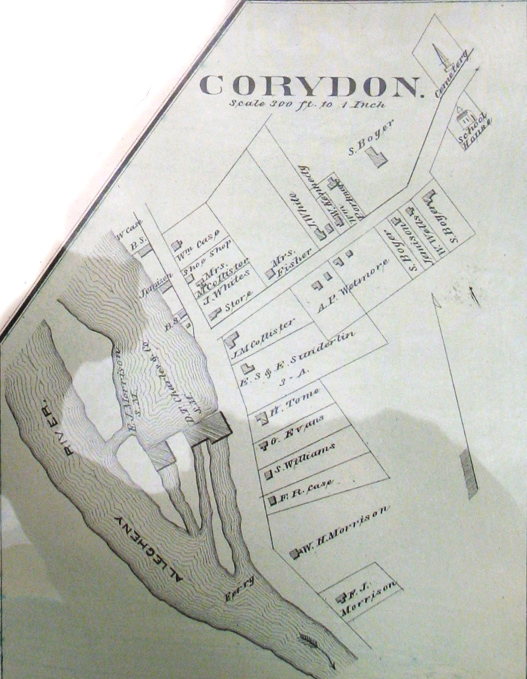CORYDON township was erected by order of the court on the 20th of March,
1846, from territory then recently set off from McKean county. It consists
of a long narrow strip of land occupying the extreme northeastern corner
of the county, and is bounded north by Cattaraugus county, N. Y., east by
McKean county, south by McKean county, and west by Kinzua and the Allegheny
River, separating it from Elk township. The drainage is furnished entirely
by Allegheny River and its numerous tributary streams, such as Cornplanter
Run, Whisky Run, Tracy Run, Willow Creek, and Sugar Creek.
There was no settlement in the present limits of the township until as late
as 1827. In 1817 James Richards passed through the land on his way to
Cincinnati, and his daughter, Mrs. Lucinda Morrison, is now a resident of
Corydon, and will be mentioned in this chapter in connection with the early
settlers. The first settler in town was undoubtedly Philip Tome. He was
born on the 22d of March, 1782, in Dauphin county, Pa., near the site of
Harrisburg. His parents were of German extraction. They moved up the
Susquehanna River about ninety miles, in 1786, in a keel boat, landing at
Farris Creek, in what was then Northumberland county. The country was
then troubled by the enmity of the Six Nations of Indians, and this family
soon thought it prudent to move back to Cumberland county. In two or three
years they went to Warry Run, about two miles above the junction of the
east branch of the Susquehanna. In 1791 they again moved, this time some
seventy miles up the west branch of that river. As early as 1816 Philip Tome
was living near the present site of Kinzua, but he soon went away and did
not return to this part of the State until 1827, when he came to the territory
now in Corydon from Lycoming county, and built a rude shanty for a temporary
dwelling place, on ground now in the center of the road which terminates
between the store on the village corner and Hale's Hotel. He came
down the river in a canoe, striking across from Canoe Place to the river. He
died on the 30th of April, 1855. A year previous to his death he wrote and
published an interesting book entitled "Pioneer Life; or Thirty years a Hunter,"
which is filled with his own adventures, some of them of the most thrilling
description. He was a great hunter, and was for fifteen years interpreter for
Cornplanter and Governor Blacksnake, Indian chiefs on the Allegheny River,
and familiar characters to the students of the early history of Pennsylvania.
Philip Tome's eldest son and second child, John C, was the first male white
child born in town. The first female child born in town was Martha Forbes,
daughter of Abel Morrison. The descendants of Philip Tome in Corydon and
other parts of the county and State are very numerous.
From Mrs. Lucinda Morrison, wife of Abel Morrison, now living in Corydon,
the writer obtained the following description of the country in 1827, when
she was brought hither. Her maiden name was Lucinda Richards. She was
born in Lisle, Broome county, N. Y., and passed through Corydon in 1817,
on the way to Cincinnati with her father, James Richards. In 1818 she was
married to Abel Morrison, who was a native of Lycoming county. In 1827
they settled on the very place now occupied by Mrs. Morrison. At first they
lived in a plank house. There were then in the whole town but three other
houses, two of logs, and one shanty. Russell Freeman lived a short distance
south of the Morrison settlement in a log house. In another log house, farther
north, had recently settled Dr. Benjamin Blodgett, the first physician, the first
postmaster, the first merchant, and the second settler in town. Still farther
north, in the shanty already mentioned, lived Philip Tome. Very soon after
the arrival of Abel Morrison came William Case. At that time the face of the
township as it is now constituted was a trackless wilderness, unrelieved by a
clearing, and inhabited by the brutal denizens—bears, deer, wolves, and occasionally
a panther. Immediately after the settlement of these few families
here, however, improvements began to make their inroads on the forests.
Mills were at once erected—partly for the profit expected from their operation,
but more immediately because of the necessity of boards for building. Abel
Morrison's mill stood where it still stands (although of course it has been many
times repaired), and is now owned by Flavius Josephus Morrison. A short
time before this was erected Enoch Oilman built a mill, the first one in town,
on the site of the large mill now in Corydon village. It was put up in the
summer of 1827, while Abel Morrison's was delayed until the following year.
Previous to 1830 one Wheeler built a mill between the other two, the same
frame standing there now and at present used by Sunderland & Payne for a
handle factory. In the winter of 1827-28 there was a school-house built of
planks, a little way northeast from the dwelling house of Abel Morrison. It
was first taught by Sabra Blodgett, a relative of Dr. Blodgett, for six months,
and under her administration it was a very efficient school. There was an
attendance of about fifteen or twenty pupils. Religious meetings were held
almost from the beginning in this school-house, and a little later; also in the
one farther down the river, and on the site of the present school-house. The
first tavern was kept by Jacob McCall, on the site of the present hotel, a number
of years previous to 1853. He also had the post-office in his tavern for a
time. The first store was kept by John Converse, a little way south of the
tavern, from the time of his arrival in 1830 until his death a number of years
thereafter. George and Augustus Wetmore and L. D. Wetmore, brothers, at
a more recent time had a saw-mill on the site of the present large mill, previous
to the erection of the pulp-mill. There has never been a grist-mill in town,
though for a brief period Alanson G., son of Abel Morrison, ground feed and
made staves and shingles on the east side of the mill now operated by his
brother.
The population of the neighborhood did not increase very rapidly for a
number of years after 1827. Several families moved in and, after a short experience
of the hardships necessarily incident to pioneer life in this wild country,
moved away. Lumbering used to be the principal business of the town, though
of late years it has greatly declined from scarcity of timber. There is now not
a tithe sawn annually as there was thirty and forty years ago.
William Case, father of Squire Case, immigrated to this town very soon
after the settlement of Philip Tome, and built his house about ten rods north
of the hotel. He married a daughter of Philip Tome, and is now living, having
survived his wife. Contemporary with Abel Morrison were his brother,
Rice Morrison, who settled about sixty rods below where the ferry now crosses
the river, where he died only a few years ago, and Russell M. Freeman, already
mentioned, who built his house on the east side of the street, near the
present ferry, and about on the site of Flavius Morrison's house. After a number
of years he moved away. Several years after this early settlement, Ira
Butler and George Smith lived on Butler's Run in the wood on the eastern
part of the present farm of George W. Tome, and there they undertook to
make brick, without very flattering success, however, and after the lapse of a
few unpropitious years they emigrated.
One of the most prominent families ever in Corydon, that of Rev. Asher
Bliss, deserves special mention, though they may not be denominated early
settlers. Rev. Asher Bliss was borni on the 20th day of February, 1801, and
on the 2d of September, 1832, married Miss Cassandra Hooper, of Boylston,
Mass. In November of the same year he began his labors as a missionary of
the A. B. C. F. M. to the Seneca Indians on the Cattaraugus Reservation.
At that time there was, it is said, but two or three framed buildings on the
entire reservation. The Indians lived in log or bark huts with no floor, and
only a hole in the roof for the exit of the smoke. Their cattle and horses had
to look out for themselves through the long winters, digging through the snow
to get a little frozen grass, and a good many of them died every winter. Mr.
Bliss early perceived the importance of raising their temporal condition as
well as their spiritual, and urged them to build comfortable houses and barns,
fence and cultivate their land, set out fruit trees, etc., and in the nineteen
years during which he prolonged his stay among them, he effected a wonderful
improvement among them in these respects. In 1851 he came to Corydon,
remaining here until 1864, when he removed to an adjoining town, South Valley,
N. Y. While in this township he organized a small church, and during
his residence here frequently preached here and in this vicinity. He also
labored among the Indians on the Allegheny Reservation, and at Cornplanter's
one or two years while in Corydon. Four sons lived to manhood, Asher, jr.,
Samuel Munson, Porter Cornelius, and David O, of whom three served in the
War of the Rebellion, and are now living in Cattaraugus county, N. Y., and
the other resides in Corydon. Rev. Asher Bliss died on the 23d of March,
1881.
Mrs. Cassandra Hooper Bliss was born at New Braintree, Mass., on the
14th of February, 1802, and died April 21st, 1878. She was descended from
the Hooper and Washburn families, of Bridgewater, Mass., from Isaac Allerton,
of Mayflower celebrity, from Robert Cushman, who preached at Plymouth the
first sermon in New England that was printed, and from Secretary Nathaniel
Morton, the first historian of New England. She received her education at
Ipswich and Amherst Academies, partly under the direction of Mary Lyon.
She was engaged for several years by Samuel Slater, the founder of the manufacture
of cotton in this country, to teach the school connected with his establishment.
Mrs. Bliss was a lady of fine personal traits of character, deeply
beloved by her associates, and by the Indians to whom she was so long a benefactress.
The most distinguished son of Rev. and Mrs. Bliss, and probably the most
distinguished person who ever resided in Corydon, was Porter Cornelius Bliss,
who is mentioned at some length in "Appleton's Annual Encyclopedia" for
1885. He was born in Erie county, N. Y., on the 28th day of December,
1838, and died in New York city on the 2d of February, 1885. He studied
at Hamilton and Yale Colleges, and in 1860 traveled through Maine, New
Brunswick, and Nova Scotia to investigate the condition of the remnants of
Indian tribes. In 1861 he went to Washington to apply for a place in the Interior
Department that would give him an opportunity to make similar investigations
beyond the Mississippi; but as he was disappointed in this, he accepted
the post of private secretary to Hon. James Watson Webb, who had just been
appointed minister to Brazil. In 1862, when Mr. Webb returned home, Mr.
Bliss went to Buenos Ayres, and was commissioned by the Argentine government
to explore the Gran Chaco, where he spent eight months in learning the
Indian dialects and investigating the antiquities. The result was published by
the government. He edited for a short time, at Buenos Ayres, the River
Platte Magazine, and then went to Paraguay, where he became private secretary
of the United States minister, Hon. C. A. Washburne, in 1866. President
Lopez commissioned him to write a history of Paraguay; but while he was
engaged in this work the war between that country and Brazil broke out, and
he fell under suspicion from the fact that he had formerly been in Brazil. The
government archives were closed to him, detectives watched him, and finally,
as he was trying to leave the country, he was thrown into prison, where he
was subjected to the most inhuman tortures to compel him to confess that he
had been a Brazilian spy. At the end of three months (December, 1868) he
was released on the demand of the United States government, backed by the
presence of a squadron of the United States navy. He went to Washington,
was a translator in the War Department for about a year, and edited the Washington
Chronicle for about a year and a half, and was then (July, 1870) appointed
secretary of legation in Mexico, which office he held for four years.
During that time he was an active member of the Mexican Geographical Society,
made archaeological explorations, and wrote much on the condition of
Mexico and its opportunities for American enterprise. By his sole personal
exertions he saved from execution three American officers in the army of Diaz,
who had been captured by the forces of Juarez, and condemned by court-martial.
In the summer of 1874 Mr. Bliss went to New York, and for the next
three years he was at work on "Johnson's Cyclopedia." After that he edited
a short-lived weekly called The Literary Table, wrote a history of the
Russo-Turkish War of 1877, and in 1879 went to South America as a correspondent
of the New York Herald. From the time of his return, a year or
two later, until his death he was in feeble health and did but little work,
though he edited the New Haven News for a part of the year 1883. He
was for two years president of the Philological Society, and was an enthusiastic
student of Oriental antiquities.
E. S. and E. Sunderlin, brothers, moved from Poultney, Vt, to McKean
county, Pa., in 1853, where they built large mills. In 1866 they came to Corydon,
kept a large store until 1873, and after that was burned began operating
the saw-mill and handle factory, the most extensive in Corydon.
The Village and its Business.—The grading of the B., N. Y. & P. Railroad
was begun in 1881, and the road was opened in the following year. Strange
as it may seem to the casual sojourner in the village of Corydon, it is a fact
that the material growth of the village has much more than doubled since that
event, and, indeed, it is said by good authorities that there was practically no
village in the township to speak of. The oil excitement and the railroad have
made it what it is in quick time. Before that for a number of years the only
merchant in town was Jay White, excepting William McCollister, who had the
same grocery business two years previous to the opening of the road that he has
now. Mr. White had kept a store, as will be seen by reference to his biographical
sketch in other pages, since 1870, in a building since torn down,
which stood on the corner opposite the hotel. E. S. and E. Sunderlin were
trading here in 1870, as stated a few lines before. While the railroad was in
process of construction, Nelson Mead purchased the site of the present office
of Mr. White, and opened the store he still occupies. Next was opened, in
1882, the hardware store of W. Rolland, who soon sold out to C. H. Whitaker,
and Whitaker to E. Price & Co., and they to J. M. Turney, the present occupant.
Then was opened the grocery of Clendenning & Hale, who sold out to
A. F. Kilburn. The building is now used by P. B. Canfield & Son, druggists,
who purchased the building of J. and S. C. Williams. C. H. Clawson came
soon after and opened a store in the building now occupied by J. E. Reynolds.
Mr. Clawson removed to his present quarters in October, 1885. On the first
of October, 1884, Joseph Green bought the stock and rented the store building
of Jay White. In 1885 he built a store of his own, which he still occupies.
In the fall of 1885 S. C Mcdintock opened a furniture store in a building belonging
to Mr. White, and still occupies it. In the spring of 1886 E. Price
and K. T. Jaquay opened a grocery under the firm name of Price & Jaquay,
and are still conducting the business.
A stave-mill was operated here three or four years by people from Frewsburg,
N. Y., who quit the business about the time that the railroad was opened.
The Jamestown Wood Pulp Company started here in 1881, and closed up their
business after about three years of operation. In 1881, also, was started here a
spoke factory, by Stedman & Aldrich, of Randolph, N. Y. They did not have
much business at first, but in 1882 Messrs. White & Jaquay purchased the interest
of Mr. Aldrich. After two years they dissolved partnership, Mr. White
taking the building and lot, which he still holds. The machinery and power
were purchased by the Corydon Spoke Company, and under this arrangement
the business is still prosecuted, the partners being Benjamin Crooks,
F. M.
Williams, and N. J. Whitcomb. In the spring of 1885 they added planing and
matching machinery. The works are in the south part of the village.
In 1881 a handle factory was opened by Sunderlin & Payne, who still
keep it in operation. The products of this factory at first were broom, fork, and
rake handles, and dolls, but latterly ax helves, pick handles, etc., are produced
in more abundance.
F. J. Morrison, son of Abel Morrison, is now operating a well-to-do saw mill
in the southern part of the village. Whitcomb & Knapp have been operating
a shingle-mill for some three years or more, which was built forty years
ago and more. Mead & Son are operating two mills for the manufacture of
railroad ties. T. J. & E. J. Reynolds also have two mills for the same purpose,
and have been for a number of years engaged in this occupation.
As stated in a previous paragraph, Dr. Benjamin Blodgett was the first
physician in the township. The one of longest practice now in town, although
living across the river, is Dr. Peter Hollister, who has practiced extensively in
this part of the country for a quarter of a century or more. Dr. A. A. Baker,
eclectic, has practiced here a little more than three years.
Hale's Hotel was built by Jacob McCall not long after the formation of the
township. Samuel Boyer kept it for some time, and was succeeded by Joseph
McCollister, who entertained the traveling public for many years with good
satisfaction. The present proprietor, Joseph H. Hale, came into this house on
the first day of October, 1885, and has entirely renovated, refitted, and rebuilt
it. He has enlarged its capacity so that there are now forty-five beds in the
house for guests.
Dr. Benjamin Blodgett was probably, from all that may be learned, the
first postmaster in Corydon township. He was succeeded by many incumbents,
among them being Amos Patterson, Ellis Gamble, William Case (Boliver
Case attended it for a time), Ellis Gamble, C. P. Bailey, Erwin Sunderlin,
Jay White, and the present postmaster, Frank Wells.
Educational and Ecclesiastical.—We have before stated that the first
school-house was built and the first school taught by Sabra Blodgett, in the
winter of 1827-28, the building being constructed 16 by 20 feet, of two-inch
plank placed horizontally, and for want of nails dovetailed at the corners. In
1831 a more substantial structure was erected and paid for by subscription.
Some years later another school was established in the lower part of the town.
There are now two districts in the township, separated by a strip of timber.
The present school-house in Corydon village—a good one—was built in 1883
at an expense of about $2,500. There are two departments. The principal
is Thomas Firth, and the assistant is Miss Emma Price. It is stated that the
attendance is about ninety.
| Undated postcard with notation in bottom left corner "High School, Corydon" |
 |
| Postcard image courtesy of Warren County Historical Society, Warren, Pa. |
Although the Methodist Episcopal denomination have had a church organization
here for many years—almost from the beginning of the history of the
township—they worshiped in school-houses, and were under the care of ministers
from other parts of the county until recent years. The present edifice,
the only one in town, was begun in the spring of 1883, and dedicated on the
26th of August, 1886. It cost about $3,000. The present pastor is Rev. S.
Dimick,
though the construction of the church was commenced under the pastorate
of the Rev. D. M. Carpenter, who was followed by Rev. William Branson.
Mr. Dimick resides at Kinzua. The church now has a membership of
about thirty. The trustees are: President, Joseph Green; secretary,
F. R.
Case; treasurer, Jay White; and the Rev. William Branson and T. P. Jaquay.
Mr. Dimick is the Sabbath-school superintendent, and M. H. Wilcox his assistant.
|





